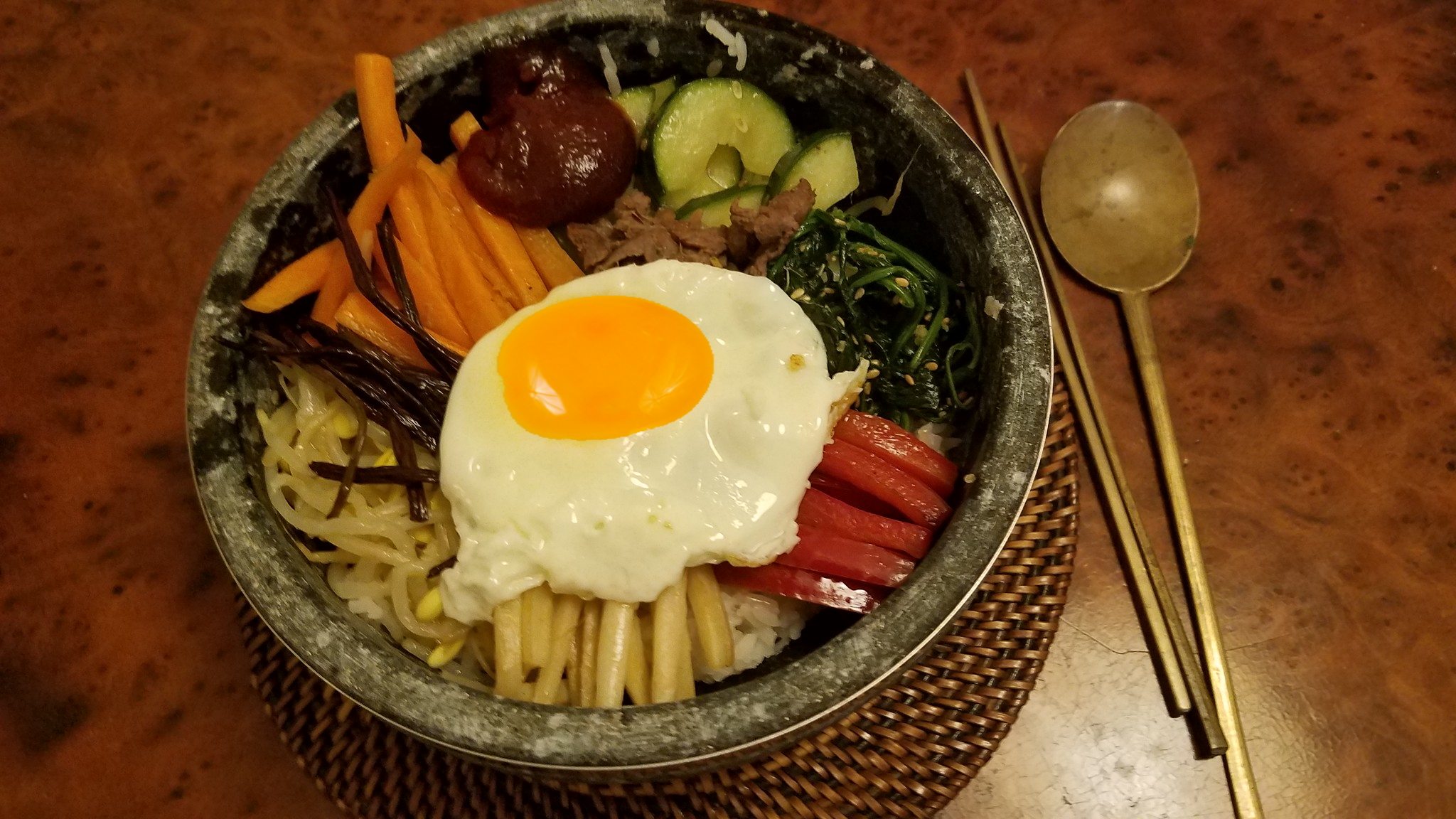
The dish's name "Bibimbap" is a portmanteau of "Bibim" which means "mixed" and "bap" meaning "rice". Bibimbap is a combination several basic ingredients: bap (warm rice), sautéed and seasoned vegetables (namul), kimchi (fermented spiced cabbage or other vegetable), chilie pepper paste (gochujang) or fermented soybean paste (doenjang), sliced meat (typically beef) and either a raw or fried egg. There are lots of variations. Unlike Japanese rice bowls, once in the individual dinner's bowl, the ingredients are mixed together before eating. As we discuss in our article The Culture of Food and Drink in South Korea, "side dishes" or banchan are an essential aspect of Korean dining. Bibimap is for all intents and purposes a typical Korean meal with all the ingredients from all the side dished mixed together in a single bowl of rice. Scholars have speculated that the dish originated with the practice of mixing food offerings at traditional jesa ancestral rites which are held on the anniversary of the death of an ancestor or close relative. Except for Protestant churches, jesa rites are practiced by Catholics, Buddhists and even those who are not religious adulterants. Bibimap is also eaten on the eve of Korean New Years in order to eat all the left-overs so that the new year could start afresh. Earliest literary references to Bibimbap date to the 16th century and the earliest known recipe dates to the late 19th century. Again, there are many different variations in Bibimap, each wiith a defining ingredient like crab, cucumber, salted shrimp, etc. Many of the variations are regionally based more than a reflection of the individual preferences.
While taste is obviously important to the balance of a good Bibimap, the color balance of the ingredients in Bibimbap is equally relevant, infused with symbolic meanings associated with cardinal directions and human physiology. Dark colors are associated with the direction North and kidneys. Red symbolises the direction South and also the heart. Green colored ingredients are tied to the direction East and the liver. The color White evokes the West and the lungs. Finally yellow colors represent the center and the stomach.
The typical method of preparing rice in Korea is to brown the rice until the bottom is crispy. The rice is first steamed or cooked in a rice cooker. Then it is browned in a skillet. Some restaurants crisp and then serve the rice in a pre-heated stone bowl (or pot) called a Dolsot. "Doslot bibimbap" is a dish prepared this way. Often it is served with a raw egg because the bowl retains heat, coming to the table sizzling hot so the egg cooks quickly when stirred into the bowl. Please note that the cooked rice should be a bit on the dry side for it to crisp properly. It will be difficult to achieve the proper texture if the rice is mushy. It is also a good idea to avoid overcooking any of the vegetables to ensure that they retain the proper texture.
Korean rice, like Japanese rice, is typically a short-grain rice. Japanese rice as well as "Calrose" rice can be found in most San Diego supermarkets.
Unlike Chinese or Japanese cultures, Koreans do not raise their rice bowls off the table when they eat from them. One reason, is that the Dolsot bowl is very hot when placed on the table. If lifted it would burn you. It is also a near universal pattern that cultural practices often develop in contrast to neighboring cultural traditions. Not only is it unusual for Koreans to raise their bowls to their mouths when eating, they also typically use both chopsticks and spoons together. These utensils are made of metal, either iron, brass or nowadays stainless steel. Korean chopsticks are also flatter than what is found in other cultures. One theory suggests that metal chopsticks originated with royalty. They were made of silver, which changed color if there was poison in the food. More modern theories suggest they are easier to keep clean and last indefinitely. Because of their greater weight and slipperiness, Korean chopsticks take a bit of practice to master.
Ingredients:
- Sesame Oil
- Soy Sauce
- 1 teaspoon sugar
- Bulgogi beef (see recipe or buy already marinaded beef)
- Toasted Sesame seeds
- 1 head of garlic (crushed or finely minced)
- 1/2 pound bean sprouts
- 1/2 pound of spinach
- 1 large carrot
- 1 red bell pepper
- 1/2 cucumber
- Small handful of Gosari (aka Fernbrake, Bracken Fiddleback Fern)
- Small handful of Doragi (Bellflower root)
- 1 Joseon radish
- Korean, Japanese or Calrose rice
- Gochujang (Korean chili paste)
Preparation:
- In separate containers soak Gosari and Doragi in salted water overnight
- Make 2 cups rice according to package instructions
- Wash spinach thoroughly
- Cut carrots, red peppers and Joseon Radish into 3 inch by 1/4 x 1/4 inch "matchsticks" (aka "julienne")
- Cut cucumber into half-rounds 1/4 inch thick.
- In individual containers generously salt the carrots, red peppers, radish and cucumber with coarse salt and let sit for 15 - 20 minutes, then squeeze out excess water.
- Drain and squeeze out the excess water from the Gosari and Doragi
- Season radish with garlic, chili powder and seasame seeds.
- Boil the Gosari in water for 10 minutes, cool in cold water and squeeze out excess water
- Cut the Gosari and Doragi into 3 inch long pieces. You may have to split some of the Doragi pieces to make thinner.
- Boil bean sprouts in salted water for 20 minutes, drain and season with sesame oil and garlic
- Blanch Spinach in boiling water for 2 minutes. Rinse with cold water and squeeze out excess water.
- Season spinach with seasame oil, toasted sesame seeds and garlic.
- Separately saute carrots and red bell pepper matchsticks in seasame oil and garlic on medium high heat for 1 minute turning continuously
- Saute the Gosari in seasami oil and then add soy sauce and sugar.
- Squeeze out as much liquid as possible from the bulgogi beef and fry it until almost done. Note: If you have a Korean barbeque grill, this works best as the beef will not steam and will taste better and have a better texture.
- Heat Dolsot bowls medium high on the stove spreading sesame oil all over the bottom. Heat until the oil just begins to smoke. (Note: I preheated the bowls for 20 minutes in a toaster oven at 350°).
- Fill the Dolsot bowl half-way with the cooked rice. Press the rice down so it makes good contact with the bowl.
- Continue heating the bowl (it should be crackling) for 8 minutes to crisp the rice.
- Array all the vegetables and add (to taste) Gochinchang chili paste.
To serve: the Dolsot bowl will be very hot, use oven mitts to move to a wooden board or trivet to serve. BE CAREFUL! At the table mix all the ingredients together in the bowl with chopsticks. Enjoy!
Recipe by T. Johnston-O'Neill
Photo by Shari Johnston-O'Neill








